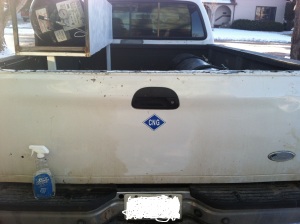Click here to read Part 1 and here to read part 2.
 Keep in mind you don’t have to make the type of rack for your tanks that I have made if you don’t want to. You could go with slightly smaller tanks and mount them under the truck along the frame rail, or you could mount them to the bed floor. I did mine this way because I wanted lots of fuel capacity and lots of attention. You should be able to get 16-20 gasoline gallon equivalent (gge) worth of storage under most full sized pickups, and about 10 gge if you simply mounted a short, fat tank across the front of the bed like a toolbox. 10 gge doesn’t sound like much, but keep in mind that you’re burning both natural gas and diesel. You’ll get between 40-50 mpg out of each gallon of diesel and about 25 mpg out of each gge of natural gas. So if you get a good, full fill on a 10 gge tank, that’s about 250 miles of driving before the gas runs out and the engine begins running on diesel only again.
Keep in mind you don’t have to make the type of rack for your tanks that I have made if you don’t want to. You could go with slightly smaller tanks and mount them under the truck along the frame rail, or you could mount them to the bed floor. I did mine this way because I wanted lots of fuel capacity and lots of attention. You should be able to get 16-20 gasoline gallon equivalent (gge) worth of storage under most full sized pickups, and about 10 gge if you simply mounted a short, fat tank across the front of the bed like a toolbox. 10 gge doesn’t sound like much, but keep in mind that you’re burning both natural gas and diesel. You’ll get between 40-50 mpg out of each gallon of diesel and about 25 mpg out of each gge of natural gas. So if you get a good, full fill on a 10 gge tank, that’s about 250 miles of driving before the gas runs out and the engine begins running on diesel only again.
Having fabricated my rack to hold my CNG tank, I drilled 13 holes all over my bed rail and floor in order to secure the rack and the tank into the bed of the pickup with grade 8 bolts. I also spot welded three of the six pieces of sheetmetal to the rack. The next time I do this, I’m going to get thinner sheetmetal. I really went overboard on this part. It’s hard to cut with a disc-type cutter and it adds a lot of unnecessary weight.
Fortunately I’ve got an DHC 2000 (formerly the Henrob 2000, formerly the Cobra) torch which welds like a TIG and cuts like a plasma cutter. It does make nice, straight cuts once you learn how to use it. Yes, it really works. Watch the videos on the website. I like TIG welding with this better than I like TIG welding with a TIG welder because I don’t have any tungstens to stick in the weld puddle that I then have to stop, re-dress, and sharpen. So, yes, you should get one. But no, it’s not necessary to have one to convert your pickup to CNG.
My first attempt at cutting looked like I used an angry beaver to cut the metal. After some fiddling and some adjustments to the regulator I got a slightly more respectable result. Continue reading →
 Click here for Part One
Click here for Part One